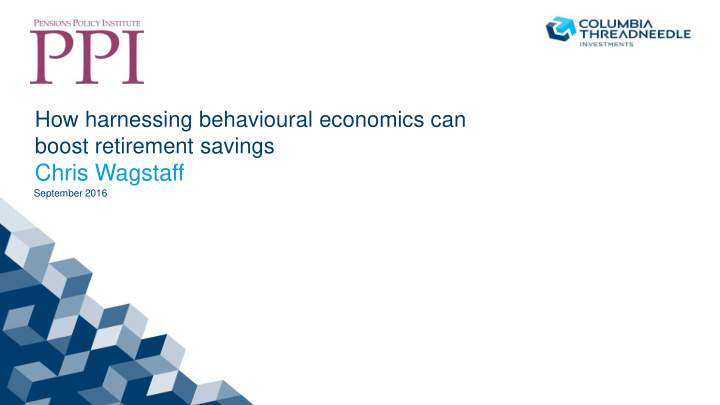



How harnessing behavioural economics can boost retirement savings Chris Wagstaff September 2016
A bag costs 5p, but that’s not the point! 2
Stick doesn’t work… 3
… but a gentle nudge often does! 4
Everyday behavioural interventions Source: Romford and Havering Post, 20 July 2016. 5
The challenge… “Addressing the inadequacy of retirement provision in the UK has arguably become the nation’s number one socio economic challenge.” Source: Chris Wagstaff, Columbia Threadneedle Investments, July 2016. Publication: Mind the gap: Overcoming the cognitive barriers to saving for retirement. 6
…is becoming more challenging against the backdrop of five secular trends Increasing time spent in retirement State pension paid ever later DB benefits disappearing Individuals forced to assume more responsibility for their financial futures Continuing prospect of more modest investment returns and yields 7
The impediments to achieving a good retirement outcome are many and various… Complexity and multiplicity of decisions Low level of basic numeracy and financial literacy Lack of frames of reference Paucity of guidance Unwillingness and/or inability to pay for financial advice Inertia “The result is a deep -seated reluctance to engage with pensions” Lack of trust 8
…and also arise from behavioural biases “The mind is a cognitive miser. It doesn’t like to expend mental energy.” David Brooks, The Social Animal, p.218 1 Present bias and anchoring result in sub optimal levels of saving Present bias Spend today rather than save for tomorrow Anchoring Minimum contribution levels used as decision making reference points 1 David Brooks. The Social Animal. Random House. 2012. ISBN 978-1-78072-037-1. 9
Overcoming present bias Overcome present bias by Visualising our future selves 1 Visualising our future selves Visualising activities will continue to enjoy Auto escalation of contributions 2 Issuing lottery tickets P A Y E W A G E IN C R E A S E = C O N T R IBUT IO N IN C R E A S E 1 Hal E. Hershfield, Daniel G. Goldstein, William F. Sharpe, Jesse Fox, Leo Yeykelis, Laura L. Carstensen, Jeremy N. Bailenson. Increasing Saving Behavior Through Age-Progressed Renderings of the Future Self. Journal of Marketing Research Vol. XLVIII (November 2011), S23 – S37. http://vhil.stanford.edu/mm/2011/hershfield-jmr-saving-behavior.pdf. 2 Richard H. Thaler, University of Chicago and Shlomo Benartzi, University of California, Los Angeles. Save More Tomorrow: Using Behavioral Economics to Increase Employee Saving . Journal of Political Economy, 2004, vol. 112, no. 1, pt. 2. 10
Overcoming anchoring Overcome anchoring to the minimum contribution by P A YE P A YE YER’S EMPL O PENSIONTAX Issuing lottery tickets CONTRIBUTIONS RELIEF Using simple frames of reference Reframing tax relief Reframing employer contributions Reinforcing positive social norms P A Y E Y O UR P E N S IO N IS W O R T H X 11
The conclusion? “Although behavioural economics doesn’t have all the answers, applying simple behavioural interventions could not only generate more optimal individual savings decisions but could ultimately lead to a retirement to be enjoyed rather than endured.” Source: Chris Wagstaff, Columbia Threadneedle Investments, September 2016. Publication: The PPI’s The Future Book: unravelling workplace pensions. 12
Important Information Past performance is not a guide to future performance. The value of investments and any income is not guaranteed and can go down as well as up and may be affected by exchange rate fluctuations. This means that an investor may not get back the amount invested. The research and analysis included in this document has been produced by Columbia Threadneedle Investments for its own investment management activities, may have been acted upon prior to publication and is made available here incidentally. Any opinions expressed are made as at the date of publication but are subject to change without notice and should not be seen as investment advice. Information obtained from external sources is believed to be reliable but its accuracy or completeness cannot be guaranteed. This material is for information only and does not constitute an offer or solicitation of an order to buy or sell any securities or other financial instruments, or to provide investment advice or services. This material is for information purposes and should not be viewed as investment, pensions, legal, regulatory or tax advice. This presentation and its contents are confidential and proprietary. The information provided in this presentation is for the sole use of those attending the presentation. It may not be reproduced in any form or passed on to any third party without the express written permission of Columbia Threadneedle Investments. This presentation is the property of Threadneedle Investments and must be returned upon request. Issued by Threadneedle Asset Management Limited. Registered in England and Wales, Registered No. 573204, Cannon Place, 78 Cannon Street, London EC4N 6AG, United Kingdom. Authorised and regulated in the UK by the Financial Conduct Authority. Columbia Threadneedle Investments is the global brand name of the Columbia and Threadneedle group of companies. 13
Recommend
More recommend